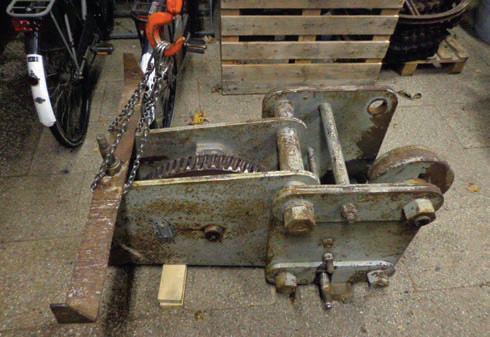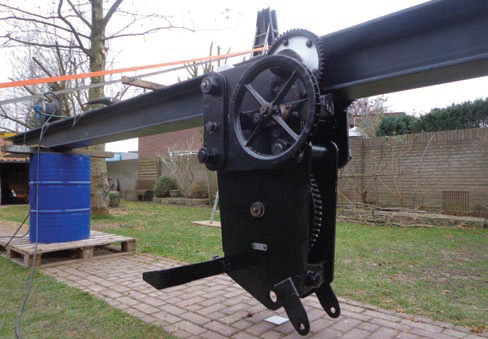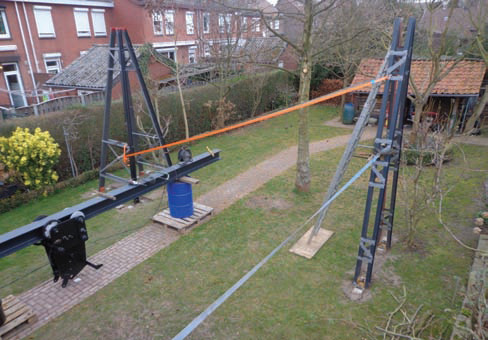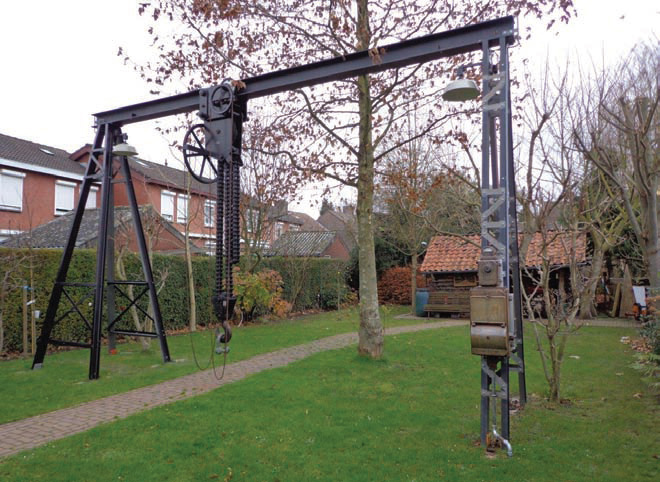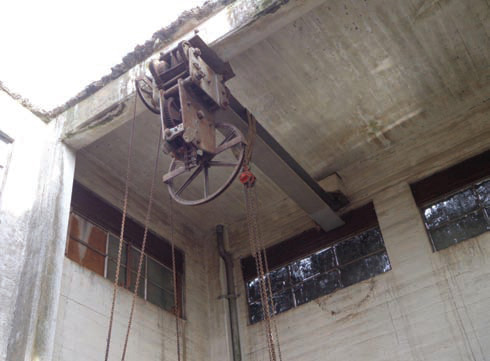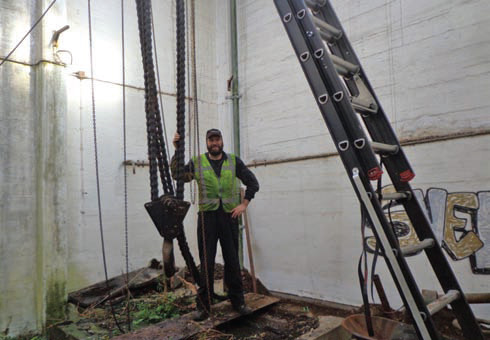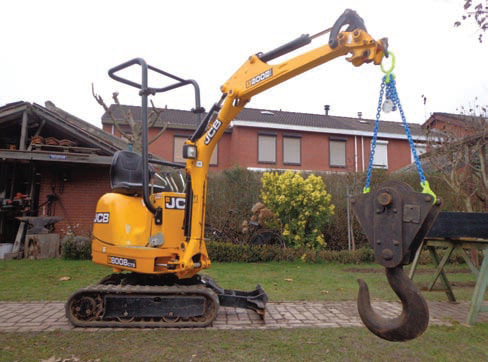Good as new
15 March 2018Engineer Marcel Koenen of Brunssum, the Netherlands, has salvaged and restored a hoist from a demolished canal lock, and installed the machinery in his garden.
Koenen’s historic project started with a lucky find. “In Maastricht there used to be an old double lock in the Julianacanal, which was built in 1936 for the local coal-mining industry, but was too low for modern shipping,” he said.. “While bridges could be built higher, the lock was, in modern times, only used for maintaining the correct water-height in times of high water, and so was due to be demolished.
“In 2015, contractor Besix started work on building a new lock, which included a bridge to replace the road that was part of the old lock, connecting the villages of Itteren and Borgharen. I went to see the pre-fabricated bridge being installed in August 2016.
“During my visit, I noticed a large hoist, hanging on a big beam, in the pump building. A week later I went to see the site manager, whom by coincidence I knew through working as a service engineer at JCB Benelux, and asked him what the plans were for the building and the hoist— he explained that everything was to be scrapped.
“If I wanted the hoist, it was mine—the only catch was that I had to dismantle it myself.
“I’m no stranger to lifting and hoisting so that seemed a great project for me. I always wanted ‘something different’ in my garden and this would be ideal!”
Koenen describes himself as a longterm crane enthusiast; his father used to work at a crane hire company that used Gottwalds, Coles, Neal, Faun and many other different makes of crane. And so, he began the project.
“A few weeks after meeting the manager, I was granted access to the pump building and made an inventory of all the materials I needed to get it out. The hoist was hanging 30ft higher than floor level, and I had no idea as to the total weight.
“At the beginning of November 2016 I gathered the materials I needed—two chain hoists, a large ladder, a generator, electrical tools and so on—and began to dismantle the hoist.
“To start, I took the chain off in two separate parts, secured and lowered by the 1.5t chain hoists. Next was the housing.
The beam from which the hoist was suspended had a large piece cut out— probably to lift the old pumps out via the roof—which gave me the opportunity to slide the hoist off the beam.
“When I was up the ladder, next to the hoist and 9m up, I could take a good look at the size of the hoist for the first time—it is huge. So, with all possible safety measures in mind, I worked out a way to pull the hoist off the beam using one chain hoist, while lowered it with another.
“Firstly, I secured it using a few overrated old straps and when I pulled it sideways, it only fell around two inches into the straps. It was now no longer suspended by the beam but was hanging in the 4t straps. After connected the second 1.5t chain hoist, I lowered it to the ground.”
The process of removing the hoist from the building took a full day, after which Koenen arranged for a wheeled loading shovel to transport the parts up the slope to the road—the pump building was situated around 8m below the level of the road.
“I took all the parts to JCB and pressure washed everything. You can imagine how it looked and smelt after years of providing a home for pigeons,” said Koenen.
“When it was finally at my house, I started dismantling every part, cleaning it, sanding it, and applying a few layers of industrial coating. I weighed each part separately as I was curious about the total weight—it turned out to be 1,025kg, including the massive hook and the chain, which I shortened. I also overhauled the mechanical parts such as the gears, and re-installed them with some fresh grease and new greasepoints.
“When the hoist was restored, I began building a frame to suspend it on. It had to be the right size to make it look good, so I bought a used HEB240 beam with a length of 7.5m, which I mounted on two self-made ‘towers’—which I gave a vintage look by using old materials. The total height reached 4.5m.
“I raised the towers myself, with help from my father, using the chain hoists, and at certain points a tree as an anchoring point. The towers are mounted on three concrete railway track sleepers which I dug into the ground.
“The next step was to work out how to get the beam and the hoist 4.5m in the air. At first I planned to use a small telehandler, but due to the ground conditions this wasn’t an option—the ground had been frozen solid during the build, but by the time I was ready to lift the beam, temperatures were above zero.
“I didn’t want to take a lot of risks and I didn’t want to ruin my lawn either, so I contacted my friends at Mammoet Geleen, who lifted the beam and hoist in one lift using a 70t Liebherr LTM1070-4.1.
“Finally I got to see the structure how I’d imagined it all along—it looked great! The next day I secured everything, and installed the chain and hook.
“In the following weeks, I installed some vintage lights with a heavy duty switch with a beautiful volt-meter, which I’d also salvaged from the old pump building. Power comes via a solar-powered switch—so the lights come on automatically when it gets dark.”
And now it’s installed, what does Koenen use it for? Nothing at all, he says: “It has absolutely no other use than enjoying it when I’m in my garden. Although it is fully functional, I don’t need to use it for lifting anything. I’m a long-time crane enthusiast, and now I finally have my own vintage crane—who can say that?”
Although the restored crane now has a long life ahead of it, its history is a mystery. “There’s an identification plate on the hook, rating it at 15t, with the year 1946 on it. The housing only has a plate on it with the maximum load and a ‘Prüfungsnummer’—inspection number— on it. So, I think it might be German, however the nuts and bolts all have Whitworth treads. I don’t have any further details. Perhaps it was custom made, It probably will remain a mystery.”
